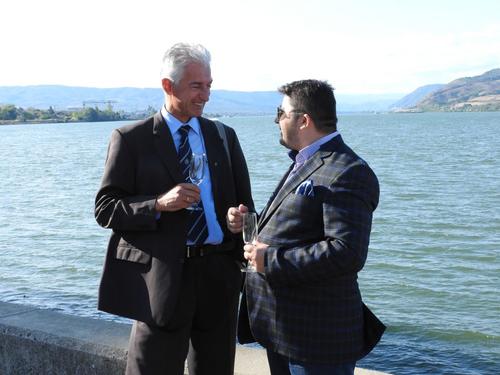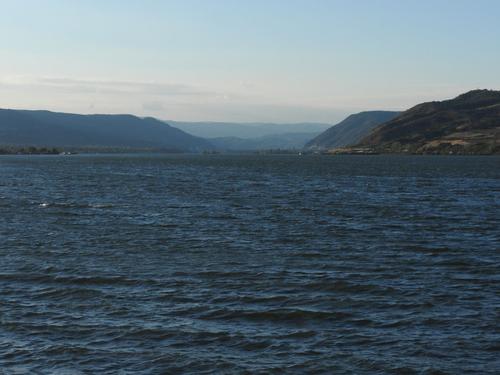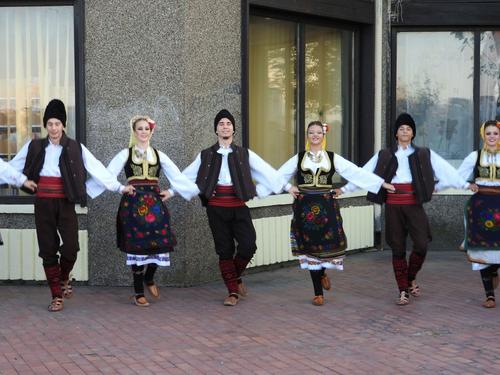++ Conservationists on the Balkans counteract national egoisms ++ Second international “European Green Belt Day” was complete success ++ Largest event in the regional section “Balkan Green Belt” took place in Serbia on the Danube ++

The mayors Srećko Nikolić, Serbia, and Stoica Marius, Romania, got into conversation during the Green Belt Day celebrations.
© EuroNatur/ Christian Stielow
The Danube near Kladovo. The picture shows the Serbian hills to the left, and the Romanian hills to the right.
© EuroNatur/ Christian Stielow
Youth in traditional costumes performing Serbian folk dances in front of the cultural centre.
© Christian Stielow / EuroNaturKladovo/Serbia, Radolfzell. Last Sunday, nature conservationists, citizens and local decision makers from various South-East European countries sent a signal for cross-border cooperation to protect the European natural heritage. Countering the current trend of isolationist policy, the people in the region got together to celebrate the “European Green Belt Day” with many events and actions.
The largest event along the former Iron Curtain took place in Kladovo, Serbia. The small town is situated in a particularly lovely part of the Danube region, right at the border to Romania. “The relationship of these two countries has not always been uncomplicated, and still today cooperation between Serbia and Romania is the exception rather than the rule. Hence, it has been a major success to unite decision makers from both countries for cross-border nature protection”, emphasizes Gabriel Schwaderer, CEO of nature conservation foundation EuroNatur, which is active throughout Europe.
After the delegation of the Romanian was welcomed by the Serbian representatives of several border communities, the celebrations around the Cultural Center in Kladovo began. The deputy mayor of the Serbian town of Majdanpek Srećko Nikolić emphasized the unifying character of the Green Belt: "Today is the beginning of an inspiring collaboration between Serbians and Romanians. I see the Danube no longer as a border between the two countries, but as a line that bridges the gap."
The fact that numerous adolescents took part in the event, was delighted by the President of the Kladovo district, Dragan Novaković. "The many young people who have come together here today give me hope that the beauty of this border region will continue to be maintained in the future.”Presentations and information desks offered the opportunity to find out about nature conservation work in the region in detail. Cultural events and culinary delights of regional products completed the very varied program.
Together with its partners, EuroNatur is working for more than 25 years along the Balkan Green Belt to prepare, establish and link cross-border protected areas. The foundation brings together conservationists and other interest groups from formerly antagonised countries to jointly develop and implement nature protection measures. The Green Belt Day, this year taking place for the second time, shall contribute to consolidating the progress achieved so far, and to making the local population enthusiastic about the natural treasures on their doorstep.
Background information:
• The European Green Belt: The European Green Belt stretches over 12,500 km, a corridor of habitats with exceptional biodiversity along the former border between East and West from the Barents Sea to the Adriatic and the Black Sea. Europe’s most ambitious conservation initiative so far intends to preserve the habitats along the former Iron Curtain as line of life. Thus, it significantly contributes to the preservation of our continent’s green infrastructure. Along the Green Belt, wild forests and marshes, biodiverse cultural landscapes, and untamed mountain ranges and river lands exist in a way that has become rare in Europe. The European Green Belt interconnects eight biogeographical regions and 24 countries and stretches across the continent in four parts. The Balkan Green Belt is the southernmost section.
• “European Green Belt Day”: The initiative celebrated the two-year anniversary of the “European Green Belt Association” with the first Green Belt Day on 24/09/2016. The association was founded by 23 governmental and non-governmental organisations from 14 countries in September 2014. For the first time, an official form of organisation represents the European Green Belt Initiative. EuroNatur acceded to the chairmanship of the association with the German environmentalist association BUND as deputy chair.
Contact:
Katharina Grund (press contact), Mail: katharina.grund(at)euronatur.org, Tel.: +49 (0)7732-92 72 10


